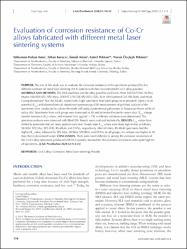| dc.contributor.author | Tuna, Süleyman Hakan | |
| dc.contributor.author | Karaca, Erhan | |
| dc.contributor.author | Aslan, İsmail | |
| dc.contributor.author | Pekkan, Gürel | |
| dc.contributor.author | Özçiçek Pekmez, Nuran | |
| dc.date.accessioned | 2022-05-11T14:28:18Z | |
| dc.date.available | 2022-05-11T14:28:18Z | |
| dc.date.issued | 2020 | |
| dc.identifier.issn | 2005-7806 | |
| dc.identifier.uri | https://doi.org/10.4047/jap.2020.12.3.114 | |
| dc.identifier.uri | https://hdl.handle.net/20.500.11776/6762 | |
| dc.description.abstract | PURPOSE. The aim of this study was to evaluate the corrosion resistance of the specimens produced by five different commercial metal laser sintering (MLS) systems with their recommended Co-Cr alloy powders. MATERIALS AND METHODS. The MLS machines and the alloy powders used were, ProX 100-ST2724G (St-Pro), Mysint 100-EOS SP2 (SP2-Mys), EOSINT 270-EOS SP2 (SP2-EOS), SLM 100-Starbond CoS (SB-SLM), and MLab Cusing-Remanium® Star (RS-MLab), respectively. Eight specimens from each group were prepared. Open circuit potential (Eocp) and electrochemical impedance spectroscopy (EIS) measurements of polished surfaces of the specimens were conducted in a three-electrode cell using a potentiostat-galvanostat in Fusayama-Meyer artificial saliva (AS). Specimens from each group were immersed in AS and de-ionized water for seven days. Eocp, charge transfer resistance (Rct) values, and released ions (?g/cm2 x 7d) in different solutions were determined. The specimen surfaces were observed with SEM/EDS. Results were analyzed statistically. RESULTS. Eocp values have shifted to potentials that are more positive over time. Steady-state Eocp values were from high to low as follows, SB-SLM, SP2-Mys, SP2-EOS, RS-MLab, and ST-Pro, respectively. After 60 mins, RS-MLab specimens had the highest Rct value, followed by SP2-Mys, SB-SLM, SP2-EOS, and ST-Pro. In all groups, ion release was higher in AS than that in de-ionized water. CONCLUSION. There were small differences among the corrosion resistances of the Co-Cr alloy specimens produced with MLS systems; meanwhile, the corrosion resistances were quite high for all specimens. © 2020 The Korean Academy of Prosthodontics. | en_US |
| dc.language.iso | eng | en_US |
| dc.publisher | Korean Academy of Prosthodontic | en_US |
| dc.identifier.doi | 10.4047/jap.2020.12.3.114 | |
| dc.rights | info:eu-repo/semantics/openAccess | en_US |
| dc.subject | Co-Cr alloy | en_US |
| dc.subject | Corrosion | en_US |
| dc.subject | Metal laser sintering | en_US |
| dc.subject | Powder | en_US |
| dc.title | Evaluation of corrosion resistance of Co-Cr alloys fabricated with different metal laser sintering systems | en_US |
| dc.type | article | en_US |
| dc.relation.ispartof | Journal of Advanced Prosthodontics | en_US |
| dc.department | Fakülteler, Diş Hekimliği Fakültesi, Klinik Bilimler Bölümü | en_US |
| dc.identifier.volume | 12 | en_US |
| dc.identifier.issue | 3 | en_US |
| dc.identifier.startpage | 114 | en_US |
| dc.identifier.endpage | 123 | en_US |
| dc.institutionauthor | Pekkan, Gürel | |
| dc.relation.publicationcategory | Makale - Uluslararası Hakemli Dergi - Kurum Öğretim Elemanı | en_US |
| dc.authorscopusid | 14834463600 | |
| dc.authorscopusid | 56387030200 | |
| dc.authorscopusid | 57217294335 | |
| dc.authorscopusid | 14834262900 | |
| dc.authorscopusid | 6508358903 | |
| dc.identifier.scopus | 2-s2.0-85087003324 | en_US |



















